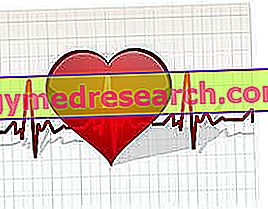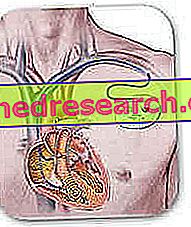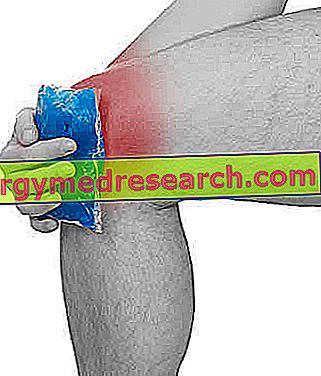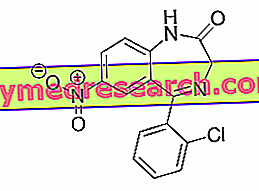Generality
Cardiac arrhythmias are alterations of the normal rhythm of contraction of the heart. These anomalies, it will be seen, do not only concern the number of heartbeats per minute, but also the propagation of the impulse that generates them.

The therapy to be adopted is in function of the cause that determines the arrhythmia. Nevertheless, there are basic therapeutic interventions, valid in any arrhythmia episode; the generic treatment consists in the administration of antiarrhythmic and beta-blocker drugs, in the use of particular medical instruments and in adopting healthy lifestyles, if the individual with an arrhythmia is accustomed to smoking or excessive drinking.
The heart
To fully understand what an arrhythmia is and what triggers it, it is good to remember some characteristics of the heart concerning its ability to self-control.
The myocardium, that is the muscle tissue of the heart, has some cells that stand out, compared to all the other cells of the human body, for two unique properties: the automaticity and the rhythmicity of the nervous impulse destined to contraction. By automaticity we mean the ability to spontaneously and involuntarily start the contraction activity of myocardial cells, generating the nerve impulse by itself. This is a real exception, as the other muscle cells in the body work differently: for example, if you want to bend an arm to lift a weight, the signal starts from the brain and reaches the muscles of the limb. In the heart, on the other hand, the signal starts from the muscle cells themselves and is not controlled by a central system such as the brain.
The second exclusive property is the rhythmicity of the spontaneous contraction activity. It consists in the regularity and in the orderly succession in time of the nervous impulse.
Therefore:
- Automaticity: it is the ability to form impulses of muscular contraction in a spontaneous and involuntary way, that is without an input coming from the brain.
- Rhythmicity: it is the ability to neatly transmit the impulses of muscular contraction.

- Atrial sinus node →
- Atrioventricular node →
- His bundle (atrioventricular bundle) →
- Purkinje fibers.
- In the same way as all the other muscle cells, these too, after the passage of the contraction impulse, are insensitive to another very close impulse over time. In other words, after a first impulse, myocardial cells need time to respond to a subsequent impulse. This time frame, necessary for muscle cells to restore receptivity, is called refractoriness .
It will be seen that a change of the dominant center and of the refractoriness can have repercussions on the regularity of the beat.
Finally, the last information not to be forgotten concerns the cardiac cycle . The cardiac cycle is the alternation of a phase of contraction of the myocardium, called systole, and of a phase of relaxation, called diastole . During the contraction, the blood is pumped in circulation through the efferent vessels; conversely, the relaxation of the myocardium allows the blood to flow into the heart through the afferent vessels.
What are cardiac arrhythmias and how they are classified
Cardiac arrhythmias are alterations of the normal heartbeat rhythm. There are three possible alterations and it is sufficient if one is present for an arrhythmia to arise. They are:
- Changes in the frequency and regularity of sinus rhythm.
- The variation of the dominant marker center location.
- Impulse propagation (or conduction) disorders.
1. Changes in the frequency and regularity of sinus rhythm, ie the normal rhythm imposed by the atrial sinus node, result in so-called tachycardias and bradycardias. Tachycardia is an increase in the rate of heart rhythm, meaning the heart beats faster than normal. Conversely, bradycardia is a slowing of the heart rate, so the heart beats more slowly. There are two threshold values, expressed in beats per minute, which delimit the normal range: 60 beats per minute is the minimum value; 100 beats per minute is the maximum value. Below 60 beats, bradycardia occurs; above 100 beats, there is tachycardia.
The so-called sinus physiological arrhythmias also manifest frequency alterations. They are not alarming episodes, they occur more often at a young age and their causes are related to central metabolism and respiratory reflexes.
2. The variation of the dominant marker center location occurs when the atrial sinus node decreases or even loses its automaticity. This therefore determines the substitution with a secondary marker point, such as the atrioventricular node. If the phenomenon is limited to a few cycles, we speak of extrasystoles, ie premature beats; if the phenomenon is maintained for a succession of cycles, one encounters junctional and ventricular tachycardias and atrial and ventricular fibrillations . They are abnormal situations that should not be underestimated, as these alterations occur, almost always, in pathological circumstances.
3. The disturbances of the propagation (or conduction) of the impulse occur as a consequence of a slowing down, or stoppage, of the impulse itself during the journey from the dominant marker center to the secondary centers. The obstacle can be caused by an anatomic interruption of the conduction route, or by a difficult restoration of the impulse response ability (prolonged refractoriness). Refractoriness can be prolonged due to:
- Drugs.
- Neurogenic stimuli.
- Pathological conditions.
Once the alterations have been clarified, the arrhythmias can be classified in at least two ways : based on the pathophysiological characteristics of the alterations (1) and on the basis of the origin of the disorder (2).
(1) The pathophysiology (ie the study of mutated functions due to a pathological condition) of the three alterations described above allows us to distinguish arrhythmias in two large groups:
- Arrhythmias mainly due to a modification of the automaticity (or impulse formation). Arrhythmias with:
- Changes in the frequency and regularity of sinus rhythm.
- Variation of the dominant marker center location.
- Arrhythmias mainly due to a modification of the conduction (or propagation) of the pulse. Arrhythmias with:
- Impulse propagation disorders.
It must be emphasized that the difference between these two groups of arrhythmias is subtle. Very often, in fact, an arrhythmia due to a modification of the conduction can turn into one due to modifications of the automaticity. For example, when a downstream obstacle opposes the conduction of the impulse coming from the atrial sinus node, this block causes the dominant pedestal center to change; the new dominant center, at that point, takes command of the rhythm. Similarly, the opposite case is also true, namely that arrhythmias due to modifications of the automaticity change into arrhythmias caused by a modification of conduction; it is the case in which a high increase in frequency does not leave the cells of the myocardium the time to return receptive, altering, consequently, the propagation of the impulse.
(2) The classification based on the place of origin of the disorder distinguishes arrhythmias into:
- Sinus arrhythmias . The disorder concerns the impulse coming from the atrial sinus node. Generally, frequency alterations are gradual. Some examples:
- sinus tachycardia
- sinus bradycardia
- sinoatrial block
- Ectopic arrhythmias . The disorder concerns a marker that is different from the atrial sinus node. Generally, they arise abruptly. The affected areas divide the ectopic arrhythmias into:
- Supraventricular. The disorder affects the atrial area. Some examples:
- atrial flutter
- atrial fibrillation
- Atrioventricular, or nodal. The affected area concerns the atrioventricular node. Some examples:
- paroxysmal supraventricular tachycardia
- junctional extrasystoles
- Ventricular. The disorder is displaced in the ventricular area. Some examples:
- ventricular tachycardia
- ventricular flutter
- ventricular fibrillation
- Supraventricular. The disorder affects the atrial area. Some examples:
It is common to use this second classification, but it must not be forgotten that it is closely linked to the first, since the variation of the site of origin of the disorder is a direct consequence of one of the physiopathological mechanisms described above.
Possible causes
Different causes contribute to the automaticity and rhythmicity changes:
- Congenital heart disease, that is, present from birth.
- Acquired cardiopathies, that is developed in the course of life.
- Hypertension.
- Cardiac ischemia.
- Myocardial infarction.
- Hyperthyroidism.
- Alcohol and drug abuse.
- Smoke.
- Drug poisoning.
Acquired heart disease can arise independently of a lifestyle characterized by alcohol and drug abuse. That's why both appear on the list. The same applies to the use of drugs.
Most frequent symptoms
The symptomatology is variable and would require a far longer description than the one that will follow. In fact, as we have seen, there are many arrhythmias, each with its own particular physiopathology and caused by different factors. This causes the symptoms to be numerous and the presence / absence of one of these distinguishes the single arrhythmia. In general, the symptom picture worsens with the severity of the arrhythmia experienced by a patient.
A list of the main symptoms is as follows:
- Tachycardia (or heart disease / palpitation).
- Bradycardia.
- Irregular beat.
- Dyspnoea.
- Chest pain.
- Anxiety.
- Dizziness and vertigo.
- Sense of weakness.
- Fatigue after minimum efforts.
It should be remembered that a cardiac rhythm is considered normal which, in terms of beats per minute, remains within the 60-100 range.
Diagnosis
A cardiological examination is the first step in diagnosing an arrhythmia. It is based on:
- Wrist measurement.
- Electrocardiogram (ECG).
- Dynamic electrocardiogram according to Holter.
Wrist measurement . It is a simple investigation, which can be done by anyone, not just by the doctor. It does not have the same reliability as an instrumental examination, clearly, and does not inform the characteristics of the arrhythmia.
Electrocardiogram (ECG) . By measuring the electrical activity of the heart, ie the one that allows the contraction of the myocardium, the ECG shows the great variety of arrhythmias that can occur in a patient. The different types of arrhythmias show different patterns from each other and the cardiologist, based on these results, can define the cardiac problem.
Dynamic electrocardiogram according to Holter . This diagnostic method works like a normal ECG, with the difference that the patient's monitoring lasts for 24-48 hours, without interruption. During this time, the patient is free to perform normal daily activities. This investigation is required when the arrhythmia occurs sporadically. In fact, it may happen that certain arrhythmias manifest themselves as isolated episodes.
Therapy
As for the symptoms, the therapy to be adopted also depends on the type of arrhythmia and any associated heart disease. Therefore, the main therapeutic interventions, both pharmacological and instrumental, will be reported below.
The drugs administered are:
- Beta blockers and calcium channel blockers . They are used to slow down the heart rate.
- Antiarrhythmics . They are used to stabilize the heart rhythm.
- Anticoagulants . They serve to thin the blood and are used to prevent the formation of thrombi or emboli in cases of particular arrhythmias, such as atrial fibrillation.
The main instrumental / surgical interventions are:
- Electrical cardioversion . It consists in applying a single electric discharge, also called shock, to reset and restore the sinus rhythm, that is the one marked by the atrial sinus node (dominant pedestal center).
- Radiofrequency ablation, or catheter ablation . It is used in patients with tachycardias. It involves the use of a particular catheter, which is inserted into the femoral veins and carried to the heart. Through the catheter, two operations are carried out: first, it gives the heart an electric discharge useful to determine which area of the myocardium works in an anomalous way. After this, the next step is to apply a radiofrequency discharge in that malfunctioning area to destroy the myocardial tissue responsible for the arrhythmia.
- Pacemaker .

- Defibrillator (ICD) . Like the pacemaker, it is also a device implanted under the skin, in this case at the level of the clavicle. It is used if the patient has tachycardia. It works in a particular way: when it senses that the heart rate is accelerated beyond the normal limit of 100 beats per minute, it emits a direct electric shock to the heart.
Since arrhythmic episodes are sometimes due to the onset of particular heart disease, describing surgical therapy would require a case-by-case analysis. For example, in the face of a valvular disease such as mitral stenosis, the surgical operation, aimed at repairing the mitral valve, re-establishes the normal heartbeat. In this case, cardiac arrhythmia is an event resulting from the mitral valve malformation.
Instead, it is much simpler to deal with sporadic arrhythmias that are not related to other pathologies, therefore not serious: these, in fact, arise after physical exercise, or a strong emotion, and are exhausted spontaneously without taking antiarrhythmic drugs. If the affected person takes high amounts of caffeine, the simple correction of the doses taken can solve the problem of cardiac arrhythmia.




